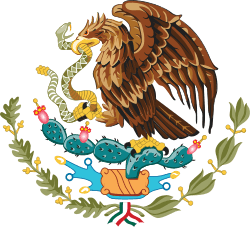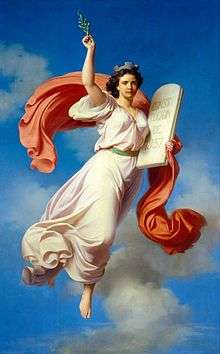La Reforma
La Reforma (English: The Reform), the Liberal Reform in Mexico, was initiated in by liberal politicians following their ouster of conservative president Antonio López de Santa Anna under the 1854 Plan de Ayutla. The Liberal Reform as a historical period is often considered to be from 1855 to 1861, as one portion of the liberal republic in Mexico, but there is not total consensus on the dates. From the liberals' initial narrow objective to remove a dictator and take power, they expanded their aims to a comprehensive program to remake Mexico governed by liberal principles as embodied by a series of Reform laws and then the embedded in a new Constitution. The major goals of this movement were to undermine the power of the Catholic Church in Mexico, separate church and state, reduce the power of the Mexican military, and integrate Mexico's large indigenous population as citizens of Mexico and not a protected class. Liberals envisioned secular education as a means to create a Mexican citizenry. The liberals' strategy was to sharply limit the traditional institutional privileges (fueros) of the Catholic Church and the army, as well as undermine indigenous communities as a protected group. Liberals promulgated a series of separate laws, collectively known as the Laws of the Reform. These were then incorporated into the Mexican Constitution of 1857. Liberals required that Mexicans swear allegiance to it, which conservatives refused to do. Instead, they formed a conservative government and fought the liberals in a civil war, the War of the Reform. It was waged over three years with liberals defeating conservatives on the battlefield. However, Mexican conservatives sought a way to regain power. They helped install a monarch, Habsburg archduke Maximilian, who was chosen by French ruler Napoleon III. Adherents of the Mexican republic, led by president Benito Juárez, resisted and fought the French intervention, successfully ousting the monarchy in 1867. The liberals returned to power, in a period known as the Restored Republic (1867-1876), often considered the end date of the reform era.[1]
Part of a series on the |
|---|
| History of Mexico |
 |
|
Spanish rule |
|
| Timeline |
|
|
Definition of the liberal reform era

The Liberal Reform is usually considered to have begun with the overthrow and exile of President Antonio López de Santa Anna in the Revolution of Ayutla in 1854-55. There is less consensus about the end point of the Reform. Common dates are 1861, after the liberal victory in the War of the Reform, 1867, after the Republican victory of the French intervention in Mexico and 1876 after the Rebellion of Tuxtepec in which liberal general Porfirio Díaz overthrew president Sebastián Lerdo de Tejada. A number of historians have called the period following the ouster of the French in 1867 the Restored Republic, when Benito Juárez returned to full power as the president of Mexico, rather than being essentially a president in exile during the French Intervention. Juárez was succeeded after his death in office by Sebastián Lerdo de Tejada. In the Cambridge History of Latin America, Jan Bazant includes the liberal reform as part of the early post-independence period and ends with the French Intervention in 1867.[2] Historian Friedrich Katz's article in the Cambridge History of Latin America, "The Liberal Republic and the Porfiriato, 1867-1910", overlaps with Bazant's, with neither calling the era "The Reform."[3] Brian Hamnett, author of a biography of Benito Juárez considers the Reform era to be from 1855 to 1876[4] as does Paul Vanderwood.[5] In A Companion to Mexican History and Culture, the reform is treated in a section entitled "Two Centuries of Independence" with one article on "Republicans and Monarchists"[6] and the other contrasting civilian rule of Juárez and Lerdo with General Díaz.[7] The first three volumes of the Historia Moderna de México (1955-), under the editorship of Mexican historian Daniel Cosío Villegas begin with the Restored Republic (República Restaurada). The framing of the era by Cosío Villegas is the subject of academic study.[8] Liberal general Porfirio Díaz ousted liberal president Sebastián Lerdo de Tejada in 1876, remaining in power practically continuously until 1911, in a period known as the Porfiriato, often treated separately from the earlier liberal era. The Porfiriato ended with the outbreak of the Mexican Revolution in 1910. The Constitutionalists, the winning faction of the Mexican Revolution, fought in the name of the liberal Constitution of 1857.
Reforms
The law prohibiting the ownership of land by corporations, the Lerdo Law, targeted the holdings of the Catholic Church and indigenous communities - confiscating Church land. Indigenous community lands were held by the community as a whole, not as individual parcels. Liberals sought to create a class of yeoman farmers that held land individually. No class of individualistic peasants developed with the Liberal program emerged, but many merchants acquired land as well as some tenant farmers. Many existing landowners expanded their holdings at the expense of peasants, and some upwardly mobile ranch owners, often mestizos, acquired land previously held by communities.[9]
The most noteworthy reforms of the Reforma were initially promulgated in a series of separate laws.
- the Ley Lerdo, abolishing corporate property holding by the Catholic Church and indigenous communal properties
- the Ley Juárez, abolishing separate military and religious courts
- the Ley Iglesias, regulating ecclesiastical fees
- the Mexican Constitution of 1857, guaranteeing many civil and political liberties including freedom of religion
- the 'Reform Laws' in which the liberal government of Veracruz during the civil war against the conservatives proclaimed complete separation of church and state.
Notable liberal leaders

Liberal Presidents of Mexico
- Juan Álvarez (1790-1867) President of Mexico in office Oct.-Dec. 1855
- Ignacio Comonfort (1812-1863), in office 1855-1857
- Benito Juárez (1806-1872), Zapotec liberal lawyer and politician, in office 1858-1872.
- Sebastián Lerdo de Tejada (1823-1889). In office 1872-1876
- Porfirio Díaz (1830-1915). In office 1876-1880; 1884-1911
Other notable figures
- Ponciano Arriaga (1811-1865)
- Santos Degollado (1811-1861)
- Manuel Doblado (1818-1865)
- Juan Antonio de la Fuente (1814-1867)
- Jesús González Ortega (1822-1881)
- José María Iglesias (1823-1891)
- José María Lafragua (1813-1875)
- Miguel Lerdo de Tejada (1812-1861)
- Ezequiel Montes (1820-1883)
- Melchor Ocampo (1814-1861)
- Manuel Payno (1810-1894)
- Guillermo Prieto (1818-1897)
- Ignacio Ramírez (1818-1879)
- Mariano Riva Palacio (1803-1880)
- Vicente Riva Palacio (1832-1896)
- Matías Romero (1837-1898)
- Ignacio Zaragoza (1829-1862)
- Francisco Zarco (1829-1869)
Paseo de la Reforma
Mexico City's main avenue is the Paseo de la Reforma which received its current name after the Reforma. It was originally known as the Paseo de la Emperatriz after Empress Carlota, the consort of Emperor Maximilian I of Mexico who created the avenue for her.
Reference
- Hamnett, Brian, "Reform Laws" in Encyclopedia of Mexico. Chicago: Fitzroy Dearborn 1997, p. 1239.
- Bazant, Jan. "From independence to the Liberal Republic, 1821-1867" in Mexico Since Independence. New York: Cambridge University Press 1991, pp. 31-48. Articles on Mexican history were collected in a single volume, published separately.
- Katz, Friedrich, "The Liberal Republic and the Porfiriato, 1867-1910" in Mexico since Independence. New York: Cambridge University Press 1991, p. 49
- Hamnett, Brian, "Reform Laws" p. 1239.
- Vanderwood, Paul, "Bettement for Whom? The Reform Period, 1855-1875" in The Oxford History of Mexico, Michael C. Meyer and William H. Beezley, eds. New York: Oxford University Press 2000, pp.371-396.
- Pani, Ericka. "Republicans and Monarchists, 1848-1867" in A Companion to Mexican History and Culture, William H. Beezley, ed. New York: Oxford University Press 2011, pp. 273-287
- Garner, Paul. "The Civilian and the General, 1867-1911", A Companion Mexican Histpry and Culture, pp. 288-301.
- Oroll, Servando and Pablo Piccato, "A Brief Hisoty of the Historia moderna de México", in A Companion to Mexican History and Culture, pp. 339-360
- Gilbert Michael Joseph; Timothy J. Henderson (2002). The Mexico Reader: History, Culture, Politics. Duke University Press. p. 239ff.
Further reading
- Bazant, Jan. Alienation of Church Wealth in Mexico: Social and Economic Aspects of the Liberal Revolution 1856-75 (Cambridge University Press, 1971)
- Brittsan, Zachary. Popular Politics and Rebellion in Mexico: Manuel Lozada and La Reforma, 1855-1876. Nashville: Vanderbilt University Press 2015.
- Callcott, Wilfred H. Liberalism in Mexico 1857-1929 (Stanford University Press, 1931)
- Hamnett, Brian R. Juarez (1994)
- Hamnett, Brian R. "Reform Laws" in Michael S. Werner, ed. Encyclopedia of Mexico: History, Society & Culture (1997) Volume: 2 pp 1239–41.
- Knowlton, Robert J. Church Property and the Mexican Reform 1856-1910 (Northern Illinois University Press, 1976)
- Powell, T.G. "Priests and Peasants in Central Mexico: Social Conflict during 'La Reforma,'" Hispanic American Historical Review (1977) 57#2 pp. 296–313 in JSTOR
- Scholes, Walter V. Mexican Politics during the Juárez Regime 1855-1872 (University of Missouri Press, 1957)
- Sinkin, Richard N. The Mexican Reform, 1856-1876:A Study in Liberal Nation-Building (University of Texas Press, 1979)
See also
- Reform laws
- Liberalism in Mexico
- Constitution of 1857
- War of the Reform (1857–1861)
- French intervention in Mexico (1861–1867)
- History of democracy in Mexico